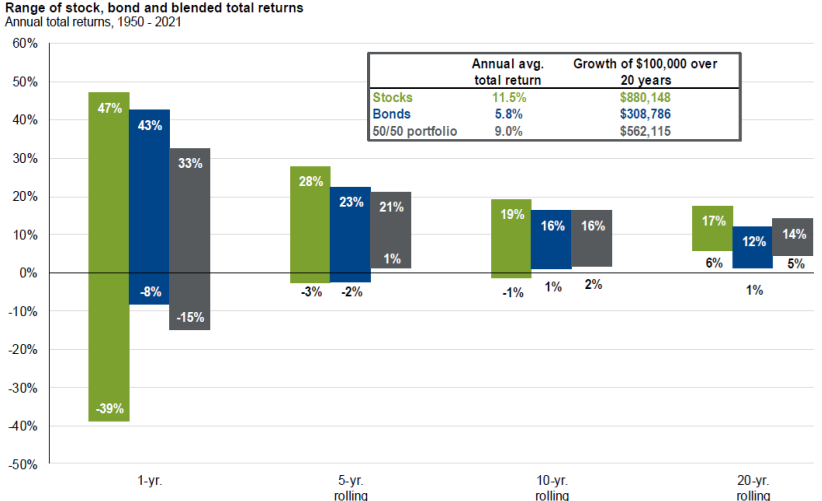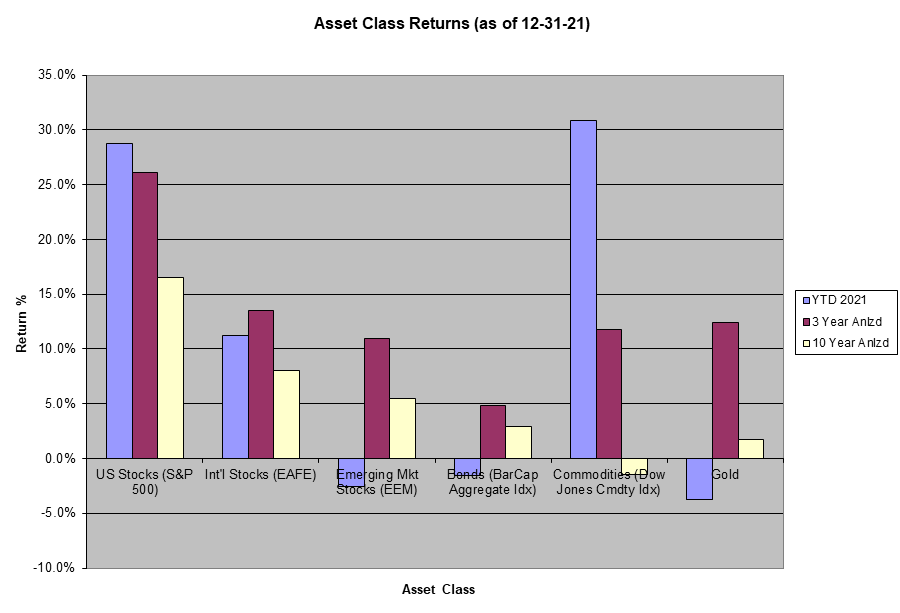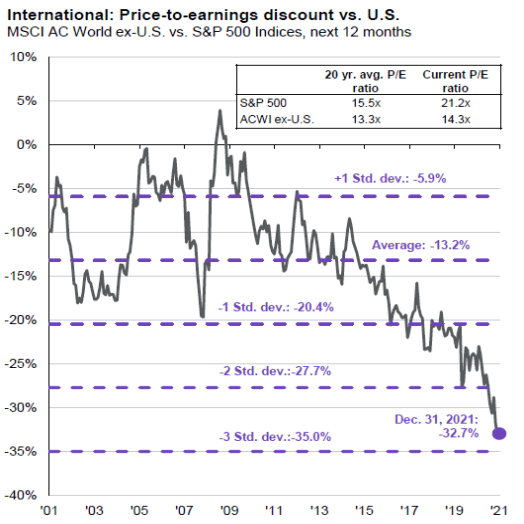The Big Picture – Staying Invested
We are strong adherents of the KISS (“keep it simple stupid”) philosophy when it comes to investing. Focus on a few things that matter: prudent asset allocation, quality of earnings and dividend growth, competitive advantage and price paid (valuation). Complicated models may help assess some of these qualities, but can sometimes do more harm than good. The more estimates you need to plug in to a spreadsheet the greater the room for error. In short, we want to buy high quality securities at reasonable prices. Then do our best to get out of the way, and let the magic of compounding do its job.
This simple process is easier said than done. We’ve written often about the constant barrage of noise and false signals that beset an investor in the day to day management of their portfolio. Should you make a change if the Fed plans to raise rates? What about expected inflation? Time to buy commodities and gold? Interest rates can only go up from here, right? Time to sell all your bonds? The list goes on and on. In our view, and this is critical, the answer to whether one should make portfolio changes based on short-term worries is generally a resounding “NO!”.
Market timing is enticing as it suggests that sidestepping sell-offs and downturns is the recipe for investment success. But consistently and successfully deploying a market timing strategy has proven elusive to the vast majority of market participants. Why? Because markets reflect the collective “wisdom of the crowd”. One timing decision might be right in the short-run, but wrong in the long-run or vice versa. If you are a market timer or event driven trader, you’ll quickly find yourself making lots of portfolio decisions; each new headline giving you another reason to possibly make a trade. In short, this style of investing violates the KISS principle.
As famed money manager Marty Zweig liked to say “The markets will always do whatever they have to do to screw over as many people as possible”. With this sage adage, it is no wonder that the vast majority of timers underperform. Instead of “playing the market” successful investing – which we will define as maximizing the return on your savings per your unique level of acceptable risk – is achieved mainly through patience and staying invested.

Source: Bloomberg, FactSet, Federal Reserve, Robert Shiller, Strategas Ibbotson, J.P. Morgan Asset Management
The nearby chart highlights the importance of staying invested over time. Over any one year investors may encounter a wide variety of outcomes; but as time goes on the odds of experiencing a negative return go down. Since 1950 there has been no rolling 20 year period of negative returns for stocks (S&P 500), and no period of negative returns greater than 5 years for a 50/50 stock bond portfolio. While this doesn’t guarantee these kinds of results in the future, it suggests a high level of confidence that time is your ally when investing. Don’t over-focus on the near-term at the expense of your long-term results.
Improving the Odds of Success
As active investors and asset allocators, we seek to improve the odds of investment success for our clients. While a focus on staying invested over the long-run is critical to maximizing long-term returns, we believe there are other important elements to the development of a successful investment strategy:
- Diversification: The above chart also highlights the importance of simple diversification in developing an appropriate asset allocation strategy. While the long-term return of stocks significantly outperforms that of bonds, incorporating bonds in to a portfolio at a 50/50 weight improved the portfolio’s resiliency to declines with no rolling period of loss greater than 5 years. While bonds, especially those with extended maturities, are arguably poor stand alone investments in the current low rate environment, shorter-term bonds still provide a ballast to a portfolio and may act as a source of opportunity capital in the event of a more significant sell off.
- Price Paid: The lower the price paid for any asset, the higher the expected return all else being equal. As active investors we may seek to improve long-term returns by tilting towards assets that offer fair, or preferably, bargain prices.
- Quality: The underlying quality of a stock or corporate bond investment can be defined many ways; financial strength, earning consistency, high returns on shareholder equity or invested capital, strong management etc. The Quality definition can also be extended to mutual funds and ETFs; those with low costs, long track records, and consistent management. Ultimately a focus on quality should help to avoid significant investment land-mines and reduce the odds of permanent capital impairment.
At AMM we manage many strategies, including index leaning asset allocation portfolios and more concentrated stock portfolios focused on businesses with strong dividend and/or secular earnings growth potential. By overlaying the above elements to these strategies we seek to improve our clients’ odds of long-term investment success.
2021 Year In Review and 2022 Outlook
For the year ending 12/31/21:
- Domestic stocks (S&P 500) increased 28.7%
- Developed international (EAFE) stocks increased 11.3%
- Emerging market (EM) stocks declined -2.5%
- Bonds (Bar Cap Aggregate) declined -1.5%
- Commodities (DJCI) were up 30.8%
- Gold declined -3.8%
We have updated our asset class return chart to reflect full year 2021 along with three and ten year annualized returns for the aforementioned asset classes.
Inflation remains a top concern for investors as we enter 2022. Consumer Price Inflation (CPI) is at levels not seen in nearly 40 years, wages are rising, and the price of nearly everything seems to be going higher. But bond yields which should rise with inflation have remained stubbornly low. This may be in part due to the Federal Reserve’s bond buying program – set to end in Q1 of this year. But there are other critical elements to consider regarding bonds and inflation. First, sovereign bond yields in countries like Germany and Japan remain negative, making U.S. ten year treasury yields of ~ 1.75% look downright attractive to foreign investors – thereby keeping a lid on rates.
Second, while the spike in inflation has been dramatic, the Federal Reserve has focused on average inflation targeting (AIT) in recent years as opposed to a steady 2% target. The AIT theory is that inflation can run hotter than normal for a period of time, as long as the average level remains subdued over time. Keep in mind that in the years following the financial crisis all the way up to the Covid 19 crisis, a primary concern of monetary authorities was the lack of inflation. The post financial crisis expansion was one of the slowest growing expansions in history – though also one of the longest. Fears of too little inflation prevailed over this period. So in many ways, the recent bout of inflation has been welcome – as long as it doesn’t stay too long.
Finally, there are major deflationary trends that remain in place despite the recent rise in inflation. Some of these, like globalization, were put on hold during Covid 19 and amplified the level of inflation in the system (see the much discussed “supply chain disruptions”). But others like technological productivity actually strengthened during the pandemic. Productivity remains near an all-time high, and continues to be a huge headwind for any kind of lasting inflation.
So where does that leave us in portfolio positioning? First and foremost, we have not changed our core approach to investing due to inflation. We continue to feel that stock investors’ best odds of long-term success is to position themselves in high quality businesses at reasonable prices. Companies that have the capacity to pay and grow dividends to shareholders provide an inherent inflation hedge since rising dividends can help offset the effects of inflation via increasing cash flow. But we like this strategy regardless of the level of CPI.
In asset allocation oriented portfolios we continue to tilt exposures to less expensive areas of the equity markets. 2021 was the year of large-cap (especially large-cap growth stocks), but we see significantly more value in small and mid-sized businesses that have not appreciated at nearly the same level as their larger siblings. We also continue to see more value in international stocks. International investing comes with its own unique risks including currency and geopolitical situations. But as the chart below highlights, at current prices international stocks offer significant relative value vs. their domestic counterparts.
For investors whose time horizon or risk tolerance requires an allocation to fixed income, we continue to favor exposure to shorter-duration assets like short-term corporate bonds and short-term treasury inflation protected securities. However a softening in inflation may cause us to reduce our exposure here. Fixed income continues to offer little by way of real inflation adjusted returns, but exposure here remains an important piece of the puzzle for those seeking to control volatility. One area of fixed income where one can obtain real yields well above the rate of inflation is private collateralized loans; which we continue to favor for qualified investors.
*Individual accounts will vary based on a client’s stated investment objectives, risk tolerance and time frame. We manage several different strategies, so not every client will have exposure to the securities, asset classes or investment strategies described above. In addition to growth and/or income oriented asset allocation strategies, we also manage more concentrated equity portfolios that generally carry a higher degree of risk and volatility. Let us know if you want to discuss your specific portfolio strategy in greater detail.
Should you have any questions regarding your investment account(s) and personal financial plans, or if there have been any recent changes to your investment and/or retirement objectives, please contact our office to speak with one of us at your convenience. We can also provide you with a current copy of our SEC Form ADV Part 2, at your request.
As always, we thank you for entrusting AMM to help you achieve your investment and retirement objectives.





